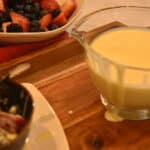Vanilla Custard Sauce (Creme Anglaise)
Vanilla Custard Sauce, also known as Creme Anglaise and English Cream is a sweet and velvety concoction made with four simple ingredients.
Servings: 4
Calories: 415kcal
Ingredients
- 1 cup heavy whipping cream
- 1 cup full fat milk
- 5 egg yolks
- ½ cup sugar
- 1½ tsp vanilla extract (SEE NOTES)
Instructions
- Measure and set all the ingredients on your counter. Timing is key so have everything at hand including all necessary utensils.
- Fill the bottom portion of your double saucepan with water and set on the stove to boil (SEE NOTES FOR ALTERNATE METHOD).
- Fill an empty bowl with ice and have another (smaller) empty bowl ready on hand to pour the custard into when ready.
- Beat the egg yolks with 2 tbsps of sugar and set aside.
- Put the milk, cream and remaining sugar in the top portion of the double saucepan and set to heat. I use my chefalarm and set it to go off when the liquid reaches a temperature of 180 degrees ( SEE NOTES FOR ALTERNATE METHOD).
- When the liquid is hot enough remove from the stove (leaving the lower pan and water cooking on the stove) and add in the vanilla extract.
- Add the hot mixture very slowly to the eggs and whisk vigorously to prevent the eggs from curdling.
- Return the entire mixture to the saucepan and return on top of the double heated saucepan. Whisk consistently till the custard starts to thicken.
- The custard is ready when it just coats the spoon and you can run a finger through the center, leaving a clean line there.
- Remove the custard and pour into the (smaller) empty bowl and place it on top of the bowl full of ice. Stir gently for a little bit to help cool the custard and leave it there till it reaches room temperature. Stir on and off to prevent a film forming on the surface.
- Pour in a container and refrigerate overnight (the custard will continue to thicken as it chills during this time)
- Enjoy your custard the next day with your favorite dessert!
Video
Notes
Vanilla Extract -
I usually opt for a vanilla bean as you just can't beat the aroma that hits you when you break open that pod and scrape the seeds out. However, if you don't have one (as I didn't the day I made my custard) make sure to use a very high quality vanilla extract.
Now when I say high quality, it can mean anywhere from $35 Madagascar Vanilla extract to $10 McCormick Vanilla Extract, but I find that the $10 variety works well and is my usual go to.
Double Saucepan -
The key to getting the custard perfect is cooking it at low heat. This allows it to cook more evenly versus the bottom thickening before the center does. The double saucepan has water at the bottom and creates steam that heats the liquid in the top compartment. This is a perfect tool for making lemon curd, melting chocolate evenly and of course making custard. If you like making dessert I would highly recommend investing in one.
If you don't have one you can create a makeshift one by using a saucepan full of boiling water and setting a metal mixing bowl on top to cook the custard in. The bowl must be made of metal for the proper conduction of heat.
IF you aren't comfortable with doing this use a regular saucepan but just control the heat well and cook at a low temperature. If you happen to mess up a little (especially if this is your first time) don't worry and keep reading...I'll tell you how to fix your slightly curdled custard .
Chefalarm/Thermometer-
A thermometer is another tool that can help you get perfect results. Remember that excess heat is your enemy when making custard. So using a thermometer to control the temperature of the milk and cream mixture can help prevent the eggs from scrambling and curdling the mixture.
I use the chefalarm by Thermoworks as shown in my video. I love it as I can set the temperature and leave the probe in the liquid. Since it beeps when the correct temperature is reached i don't have to stand on top of my pot and watch my milk boil. This gives me the time to do other tasks without the risk of ruining my recipe.
However, if you don't have the chefalarm then use a regular cooking thermometer to check the temperature of the liquid. You will need to be a bit more vigilant as the milk and cream mixture should not heat to more than 180 degrees F.
Fixing Curdled Custard -
Now let's suppose you've done all of the above but still managed to have a slightly curdled custard. If it's not completely scrambled and lumpy it can easily be salvaged in one of two ways:
- Slightly grainy custard can be strained through a fine mesh sieve and it's texture revived.
- If you feel it's a bit too grainy for the sieve to fix, or if you prefer something quicker, take the slightly warm custard and run it through the blender. If you feel the need you can even add a tablespoon or two of heavy whipping cream to help regain the desired velvety texture.
Nutrition
Serving: 1g | Calories: 415kcal | Carbohydrates: 30g | Protein: 7g | Fat: 30g | Saturated Fat: 17g | Polyunsaturated Fat: 2g | Monounsaturated Fat: 9g | Cholesterol: 332mg | Sodium: 59mg | Potassium: 150mg | Sugar: 28g | Vitamin A: 1295IU | Vitamin C: 1mg | Calcium: 135mg | Iron: 1mg
